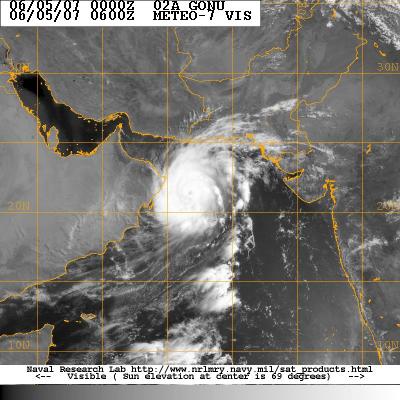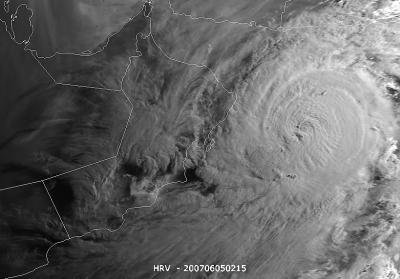hab selbst schon so halb was gefunden:
https://metocph.nmci.navy.mil/jtwc/warn ... 207web.txt
aber um weitere links immer dankbar.
REMARKS:
041500Z POSITION NEAR 20.1N 63.7E.
TROPICAL CYCLONE (TC) 02A (GONU), LOCATED APPROXIMATELY 380 NM
SOUTHEAST OF MUSCAT, OMAN, HAS TRACKED NORTHWESTWARD AT 10 KNOTS
OVER THE PAST 06 HOURS. TC 02A CONTINUES TO TRACK NORTHWESTWARD
ALONG THE SOUTHWESTERN PERIPHERY OF A MID-LEVEL STEERING RIDGE
ANCHORED OVER CENTRAL INDIA. THE SYSTEM WILL ENCOUNTER A SECOND
RIDGE ANCHORED OVER THE ARABIAN PENINSULA AS IT CONTINUES TO
TRACK NORTHWESTWARD THROUGH TAU 48. A WEAKNESS EXISTS BETWEEN
THE TWO RIDGES DUE TO A SERIES OF MID-LATITUDE SHORTWAVE TROUGHS
THAT CONTINUE TO TRANSIT NORTH OF THE SYSTEM. THIS WEAKNESS IS
FORECAST TO REMAIN OVER SOUTHERN IRAN AND THE STORM IS EXPECTED
TO TRACK INCREASINGLY NORTHWARD TOWARD THE COAST OF IRAN AFTER
TAU 48. THE NOGAPS AND GFDN NUMERICAL MODELS DEPICT THIS STRONG
WEAKNESS BETWEEN THE RIDGES AND INDICATE A MORE NORTHWARD TRACK
INTO THE GULF OF OMAN. EGRR, GFS, ECMWF AND AFWA MM5 DEPICT A
STRONGER RIDGE OVER SAUDI ARABIA AND THEREFORE LESS OF A TURN
NORTHWARD. THIS FORECAST IS BASED ON A CONSENSUS OF THE AVAILABLE
AIDS. THE STORM CONTINUES TO REMAIN UNDER THE AXIS OF AN UPPER
LEVEL RIDGE, KEEPING VERTICAL WIND SHEAR LOW. WESTWARD AND POLEWARD
OUTFLOW REMAINS FAVORABLE. THE STORM HAS SLIGHTLY INCREASED IN
INTENSITY OVER THE PAST SIX HOURS, BUT IS NOW BEGINNING TO SHOW
SIGNS OF WEAKENING. THE SYSTEM IS EXPECTED TO WEAKEN SLIGHTLY OVER
THE NEXT 24 HOURS AS IT MOVES OVER WATER WITH LOWER OCEAN HEAT
CONTENT, BUT MAINTAINS FAVORABLE UPPER LEVEL OUTFLOW. TC 02A IS
FORECAST TO WEAKEN MORE QUICKLY AFTER TAU 24 DUE TO THE ENTRAINMENT
OF DRY AIR FROM THE ARABIAN PENINSULA AND THEN LAND EFFECTS AFTER
LANDFALL JUST AFTER TAU 36 ALONG THE NORTHEAST COAST OF OMAN. DUE
TO LAND EFFECTS AND THE ENTRAINMENT OF DRIER AIR, TC 02A IS NOT
EXPECTED TO INTENSIFY AS IT TRACKS BACK OVER THE GULF OF OMAN BY
TAU 72. MAXIMUM SIGNIFICANT WAVE HEIGHT AT 041200Z IS 40 FEET.
NEXT WARNINGS AT 042100Z, 050300Z, 050900Z AND 051500Z.//



